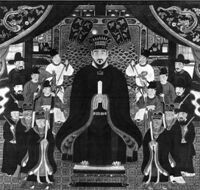Difference between revisions of "Sho Genko"
From SamuraiWiki
Jump to navigationJump to search| Line 1: | Line 1: | ||
[[Image:King Sho Nei.jpg|right|thumb|200px|A posthumous portrait of King [[Sho Nei|Shô Nei]] (r. 1587-1620), painted by Shô Genko in 1796.]] | [[Image:King Sho Nei.jpg|right|thumb|200px|A posthumous portrait of King [[Sho Nei|Shô Nei]] (r. 1587-1620), painted by Shô Genko in 1796.]] | ||
| − | *''Born: [[1784]]'' | + | *''Born: [[1784]]/11/13'' |
| − | *''Died: [[1841]]'' | + | *''Died: [[1841]]/12/9'' |
*''Other Names'': 小橋川朝安 ''(Kobashigawa Tomoyasu)'' | *''Other Names'': 小橋川朝安 ''(Kobashigawa Tomoyasu)'' | ||
*''Japanese'': [[向]]元瑚 ''(Shou Genko)'' | *''Japanese'': [[向]]元瑚 ''(Shou Genko)'' | ||
Shô Genko, also known by the [[Okinawan name|Japanese-style name]] Kobashigawa Tomoyasu, was a painter who served under five successive kings of [[Kingdom of Ryukyu|Ryûkyû]]. He is best known for his posthumous royal portraits of the kings of the kingdom, but is said to have also been a master of, in particular, [[bird-and-flower painting]], and paintings of tigers. | Shô Genko, also known by the [[Okinawan name|Japanese-style name]] Kobashigawa Tomoyasu, was a painter who served under five successive kings of [[Kingdom of Ryukyu|Ryûkyû]]. He is best known for his posthumous royal portraits of the kings of the kingdom, but is said to have also been a master of, in particular, [[bird-and-flower painting]], and paintings of tigers. | ||
| + | |||
| + | Genko was born in [[Shuri]], and was elevated to the [[Ryukyuan court ranks|rank]] of ''ueekata'' in [[1843]].<ref>''Okinawa bijutsu zenshû'' vol 6, Okinawa Times (1989), 65.</ref> | ||
Many of his works were stored at his former home for many years, but most were destroyed in the 1945 battle of Okinawa. | Many of his works were stored at his former home for many years, but most were destroyed in the 1945 battle of Okinawa. | ||
| Line 11: | Line 13: | ||
==References== | ==References== | ||
*"[http://ryukyushimpo.jp/news/storyid-41733-storytopic-121.html Shô Genko]." ''Okinawa konpakuto jiten'' (沖縄コンパクト事典, "Okinawa Compact Encyclopedia"). Ryukyu Shimpo. 1 March 2003. Accessed 22 February 2010. | *"[http://ryukyushimpo.jp/news/storyid-41733-storytopic-121.html Shô Genko]." ''Okinawa konpakuto jiten'' (沖縄コンパクト事典, "Okinawa Compact Encyclopedia"). Ryukyu Shimpo. 1 March 2003. Accessed 22 February 2010. | ||
| + | <references/> | ||
[[Category:Artists and Artisans]] | [[Category:Artists and Artisans]] | ||
[[Category:Ryukyu]] | [[Category:Ryukyu]] | ||
[[Category:Edo Period]] | [[Category:Edo Period]] | ||
| + | [[Category:Nobility]] | ||
Revision as of 07:58, 29 January 2017

A posthumous portrait of King Shô Nei (r. 1587-1620), painted by Shô Genko in 1796.
- Born: 1784/11/13
- Died: 1841/12/9
- Other Names: 小橋川朝安 (Kobashigawa Tomoyasu)
- Japanese: 向元瑚 (Shou Genko)
Shô Genko, also known by the Japanese-style name Kobashigawa Tomoyasu, was a painter who served under five successive kings of Ryûkyû. He is best known for his posthumous royal portraits of the kings of the kingdom, but is said to have also been a master of, in particular, bird-and-flower painting, and paintings of tigers.
Genko was born in Shuri, and was elevated to the rank of ueekata in 1843.[1]
Many of his works were stored at his former home for many years, but most were destroyed in the 1945 battle of Okinawa.
References
- "Shô Genko." Okinawa konpakuto jiten (沖縄コンパクト事典, "Okinawa Compact Encyclopedia"). Ryukyu Shimpo. 1 March 2003. Accessed 22 February 2010.
- ↑ Okinawa bijutsu zenshû vol 6, Okinawa Times (1989), 65.